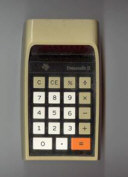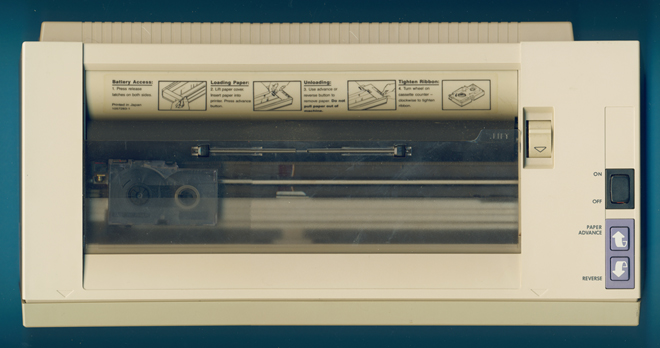
DATAMATH CALCULATOR MUSEUM
 |
DATAMATH CALCULATOR MUSEUM |
Texas Instruments HX-1010 Printer 80
| Date of introduction: | 1983 | Display technology: | |
| New price: | $249.95 (MSRP 1983) | Display size: | |
| Size: | 6.4" x 12.5" x 1.9" 163 x 318 x 48 mm3 |
Printer technology: | Thermal Transfer |
| Weight: | 44.7 ounces, 1266 grams | Serial No: | A0003455 |
| Batteries: | 4*D Alkaline | Date of manufacture: | mth 04 year 1984 |
| AC-Adapter: | AC9401 | Origin of manufacture: | Japan |
| Precision: | Integrated circuits: | ||
| Memories: | HEX-BUS Device ID: | 16,17 | |
| Program steps: | Courtesy of: | Joerg Woerner |

![]()
 Texas Instruments designed in 1982 with the HEX-BUS a very innovative interface to connect
intelligent peripherals like printers, modems or even a video interface to its new Compact Computer System
CC-40 and planned to use it with the
never released TI-99/8 home computer.
Texas Instruments designed in 1982 with the HEX-BUS a very innovative interface to connect
intelligent peripherals like printers, modems or even a video interface to its new Compact Computer System
CC-40 and planned to use it with the
never released TI-99/8 home computer.
 The physical interface of the HEX-BUS is a rather simple 8-pin
connector and with peripherals having always two HEX_BUS ports, multiple
peripherals can be connected in a daisy-chain mode. The Hardware of the HEX-BUS uses four Data-Signals [D0, D1, D2, D3], two Handshake-Signals
[HSK], [BAV] and a common ground signal [GND]. The remaining line was reserved
for future use and labeled [FUT]. With the drivers being "open collector", the
interface allows bi-directional data communication, each Byte is transmitted in
two 4-bit words in a Master/Slave protocol. Texas Instruments published not only
the specifications of the HEX-BUS and the software requirements for peripherals,
but even offered two different Intelligent Peripheral Bus Controllers (IBC),
realized as ASICs (Application Specification Integrated Circuits):
The physical interface of the HEX-BUS is a rather simple 8-pin
connector and with peripherals having always two HEX_BUS ports, multiple
peripherals can be connected in a daisy-chain mode. The Hardware of the HEX-BUS uses four Data-Signals [D0, D1, D2, D3], two Handshake-Signals
[HSK], [BAV] and a common ground signal [GND]. The remaining line was reserved
for future use and labeled [FUT]. With the drivers being "open collector", the
interface allows bi-directional data communication, each Byte is transmitted in
two 4-bit words in a Master/Slave protocol. Texas Instruments published not only
the specifications of the HEX-BUS and the software requirements for peripherals,
but even offered two different Intelligent Peripheral Bus Controllers (IBC),
realized as ASICs (Application Specification Integrated Circuits):
|
• TI # 1052911, LSI Logic ASIC L1A0037, 22 pin Package • TP0370, new version, 28 pin package |
Texas Instruments dropped out of the home computer market in March 1984 - after selling more than 2.5 million of the famous TI-99/4A - and production of the CC-40 was ceased immediately after. Consequently was the development of the HEX-BUS terminated and only a few of the already announced HEX-BUS peripherals were manufactured in significant quantities. Interesting fact to know: The TI-74 BASICALC and TI-95 PROCALC computers introduced in 1985 as successor of the CC-40 use a 10-pin Dock-Bus which is compatible to the HEX-BUS and added three signals: [RESET] and System Power Distribution In [PI] and Out [PO] to power peripherals from the computer or the computer from peripherals.
Texas Instruments announced or released during the short live of the Compact Computer 40 eight different products like printers, plotters and even a serial interface using the HEX-BUS Interface. Additional peripheral devices were planned or released from Third Party vendors but are not listed as of now in our overview:
Part |
Name / Description |
MSRP (1983) |
Status |
| HX-1000 | Printer / Plotter 4 colors | $199.95 | Series |
| HX-1010 | Printer 80 (Thermal ribbon) | $249.95 | Series |
| HX-1100 | Video Interface | $99.95 | Prototype |
| HX-2000 | Wafertape Digital Tape Drive | $139.95 | Prototype |
| HX-3000 | RS-232 Interface | $99.95 | Series |
| HX-3000/P | RS-232 + Parallel Interface | $124.95 | Series |
| HX-3100 | Data Modem | $99.95 | Series |
| HX-5102 | Disk Drive/Controller | t.b.d. | Prototype |
Texas Instruments introduced with the HX-1010 Printer 80 a battery operated, portable and yet low cost printer that connects with the HEX-BUS Interface to the Compact Computer System CC-40 and other devices supporting the HEX-BUS specifications. The HX-1010 prints up to 80 characters per line at a speed of up to 20 characters per second on normal 8.5" wide paper.


 The
HX-1010 uses thermal transfer printing print technology using small ribbon
cassettes that were sold in packs of two at about $5 per cassette. With one
cassette lasting typically about 32 double-spaced pages, the printer might have
been cheap, printing not. A poor man's solution was using thermo paper used with
fax machines...
The
HX-1010 uses thermal transfer printing print technology using small ribbon
cassettes that were sold in packs of two at about $5 per cassette. With one
cassette lasting typically about 32 double-spaced pages, the printer might have
been cheap, printing not. A poor man's solution was using thermo paper used with
fax machines...
Looking closer into a HX-1010 Printer 80
manufactured in April 1984 by Brother Industries of Nagoya, Japan reveals a
print mechanism labeled "EP-20"!
 Brother
introduced in September 1982 with the EP-20 the World's first electronic thermal
battery-operated typewriter. It uses a small LC-Display holding the last 16
characters of the line you type, allowing corrections to be made before
it goes on paper. The EP-20 is powered with four D batteries, too and was
selling around $200 in 1983, putting the MSRP of $249.95 for the HX-1010 into
perspective.
Brother
introduced in September 1982 with the EP-20 the World's first electronic thermal
battery-operated typewriter. It uses a small LC-Display holding the last 16
characters of the line you type, allowing corrections to be made before
it goes on paper. The EP-20 is powered with four D batteries, too and was
selling around $200 in 1983, putting the MSRP of $249.95 for the HX-1010 into
perspective.
![]()
If you have additions to the above article please email: joerg@datamath.org.
© Joerg Woerner, October 25, 2019. No reprints without written permission.